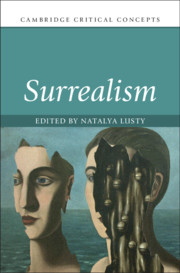Book contents
- Surrealism
- Cambridge Critical Concepts
- Surrealism
- Copyright page
- Contents
- Illustrations
- Notes on Contributors
- Acknowledgments
- Introduction: Surrealism’s Critical Legacy
- Part I Origins: Ideas/Concepts/Interventions
- Part II Developments: Practices/Cultures/Material Forms
- Part III Applications: Heterodoxies and New Worlds
- Chapter 14 Surrealism and Schizoanalysis
- Chapter 15 The Surrealist Bestiary and Animal Philosophy
- Chapter 16 Picasso’s Habits: André Breton on Art, Nature and Reflexivity
- Chapter 17 Surrealism and Mass-Observation
- Chapter 18 Pacific Surrealism
- Chapter 19 Decolonial Surrealism
- Chapter 20 Surrealism and écriture féminine
- Chapter 21 Subcultural Receptions of Surrealism in the 1960s International Underground Press
- Select Bibliography
- Index
Chapter 16 - Picasso’s Habits: André Breton on Art, Nature and Reflexivity
from Part III - Applications: Heterodoxies and New Worlds
Published online by Cambridge University Press: 23 July 2021
- Surrealism
- Cambridge Critical Concepts
- Surrealism
- Copyright page
- Contents
- Illustrations
- Notes on Contributors
- Acknowledgments
- Introduction: Surrealism’s Critical Legacy
- Part I Origins: Ideas/Concepts/Interventions
- Part II Developments: Practices/Cultures/Material Forms
- Part III Applications: Heterodoxies and New Worlds
- Chapter 14 Surrealism and Schizoanalysis
- Chapter 15 The Surrealist Bestiary and Animal Philosophy
- Chapter 16 Picasso’s Habits: André Breton on Art, Nature and Reflexivity
- Chapter 17 Surrealism and Mass-Observation
- Chapter 18 Pacific Surrealism
- Chapter 19 Decolonial Surrealism
- Chapter 20 Surrealism and écriture féminine
- Chapter 21 Subcultural Receptions of Surrealism in the 1960s International Underground Press
- Select Bibliography
- Index
Summary
In André Breton’s 1933 essay “Picasso in His Element” for the journal Minotaure, the surrealist poet underlines the intertwinement between Picasso’s recent sculptures and his studio environment, which the photographer Brassaï documented in such a way as to reflect Picasso’s everyday habits. Drawing on the philosophy of Hegel and Ravaisson, this chapter explores the preeminence of nature in Breton’s essay in terms of questions of materiality and habit, the latter being a common trait shared by humans and animals. In light of Roger Caillois’s contemporaneous effort to make nature the new paradigm for a revised theory of automatism, it is argued that Breton’s reading of Picasso’s work and environment advances instead a theory of art as self-reflexive nature, which recognizes the material continuity between art and nature without reducing their relationship to one of homology.
- Type
- Chapter
- Information
- Surrealism , pp. 291 - 309Publisher: Cambridge University PressPrint publication year: 2021

